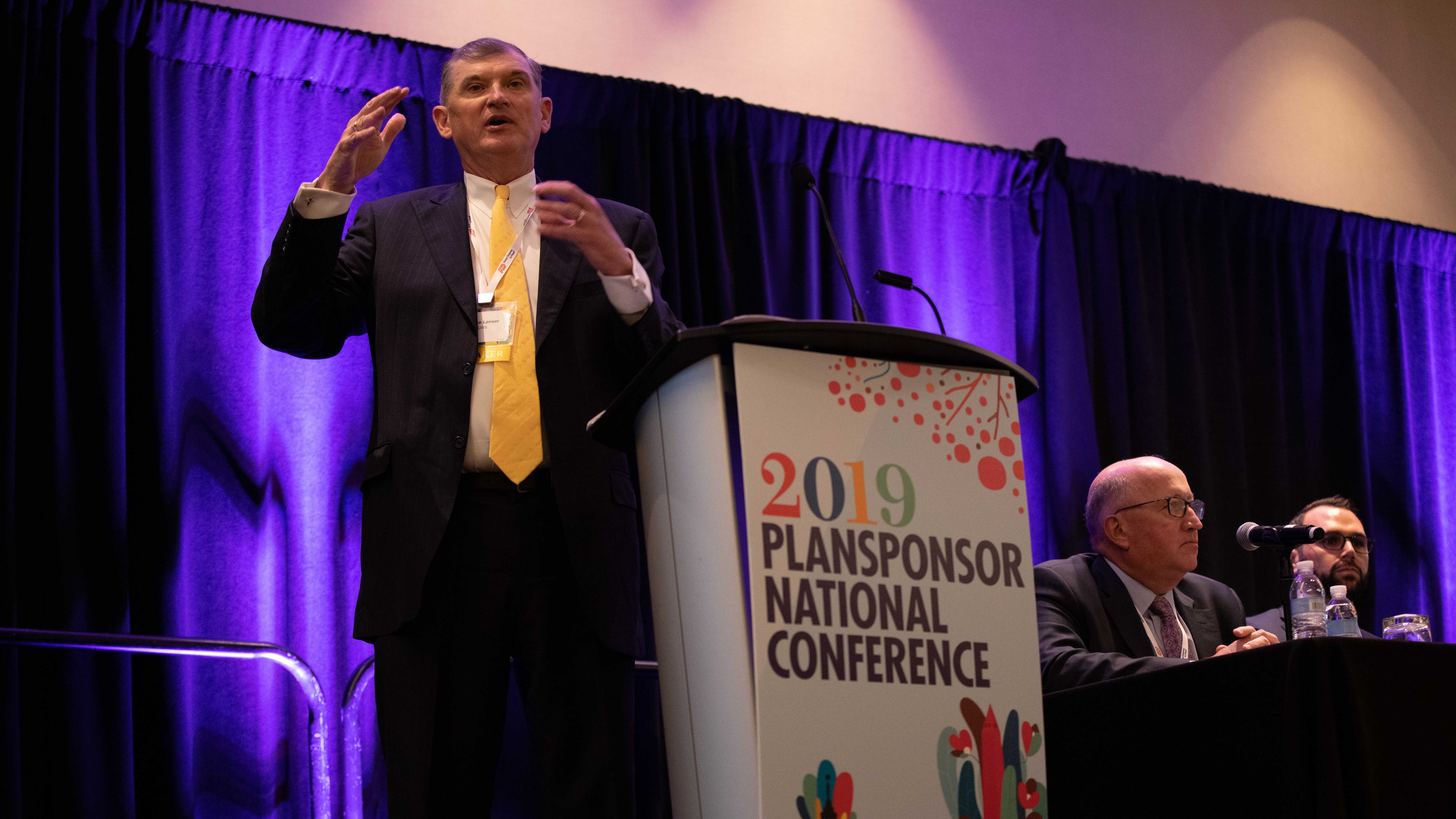For more stories like this, sign up for the PLANSPONSOR NEWSDash daily newsletter.
PSNC 2019: What Comes Next With Retirement Income
The growing landscape of decumulation solutions includes in-plan insurance products, managed payout funds, managed accounts, out-of-plan annuity windows and more.

From left to right, Bruce Lanser of UBS, John Doyle of Capital Group and Nick Nefouse of BlackRock. Photograph by Matt Kalinowski
As a greater and greater percentage of workers accumulate most of their wealth in defined contribution (DC) retirement plans, it means they will increasingly look to their plan sponsor for guidance about how to decumulate assets.
With this trend in mind, the second day of the 2019 PLANSPONSOR National Conference (PSNC) in Washington, D.C., featured a panel discussion on the topic of “Understanding Retirement Income Products.” Speakers included Bruce Lanser, senior retirement plan consultant with UBS Retirement Plan Consulting Group; John Doyle, senior vice president and senior retirement strategist at Capital Group/American Funds; Marty Menin, senior director of retirement solutions at Pacific Life Insurance Co.; and Nick Nefouse, head of defined contribution investment strategy and co-head of LifePath Solutions at BlackRock.
Drawing on a significant amount of collective experience in addressing the “decumulation challenge,” panel members all said there is clear agreement among providers, advisers and plan sponsors that converting retirement savings into income is overwhelming for participants. While all workers share the accumulation goal of maximizing their savings during their working years, the subject of how to spend those dollars is far more complex, given differences in longevity, lifestyle preferences and legacy intentions—just to name a few of the complicating factors.
“Progressive sponsors are always coming to us on this topic. They have their goals lined out, and they are asking, how can you make decumulation work for us?” Menin said. “In my estimation, we’re still at the early stages of this discussion, even though a lot of work has been done on this subject already. The future is very uncertain in this respect; there are going to be different ways to do retirement income.”
According to Nefouse and the others, part of what makes the discussion of decumulation difficult is that there will be no silver bullet solution that simplifies the process for large swaths of people—say, in the way target-date funds (TDFs) have dramatically simplified the accumulation side of the equation.
“BlackRock, for our part, has been trying for the better part of 10 or 15 years to solve these questions, and it’s still an ongoing effort,” Nefouse said. “Retirement income solutions must solve for mortality risk and income security. While we know pooled insurance products can go a long way toward addressing these challenges, the unique features of defined contribution plans make annuitization challenging. There are issues about portability, liquidity and education.”
Doyle noted that the topic of in-plan retirement income is becoming more prevalent because plan sponsors increasingly encourage their participants to remain in the plan post-retirement. He said sponsors want to make sure their plans maintain scale while participants maintain access to institutionally priced investments. Beyond these factors, sponsors like the idea of retirees still enjoying the fiduciary oversight and conflict of interest protections associated with tax-qualified retirement plans governed by the Employee Retirement Income Security Act (ERISA).
“As DC plans become a main source of retirement income, people are questioning whether it’s right to just roll out of the plan,” Doyle said. “We have a maturing DC system at the same time that the regulatory environment is encouraging more people to stay in the plan. There are many reasons to encourage people to stay around in the plan post-retirement. This is a new way of thinking.”
Menin predicted that, should the SECURE [Setting Every Community Up for Retirement Enhancement] Act become law and mandate that plans provide monthly income projections alongside the lump-sum account balances, this could have a surprising impact beyond the discussion of annuities. He said he expects that some people could be motivated to save more after seeing such projections, while others could be discouraged.
“I’m interested to see what impact this mandate could have,” Menin observed. “At current rates, people will see a $100,000 net balance projected to give them only about $500 a month via an immediate annuity. I wonder, will this discourage or encourage savings? It could actually be discouraging to some people, and they will wonder, why would I even make the effort to save?”
The panel also agreed that the SECURE Act’s proposal to create an ERISA safe harbor applying to plan sponsors’ selection of an in-plan annuity provider might not be the decumulation panacea that some anticipate.
“When I talk to plan sponsors today about why they don’t have an annuity option in their plan right now, fiduciary liability is far from their top issue,” Doyle said. “Instead, they are worried about issues having to do with portability and concerns about what would happen with a recordkeeper change, for example. In my view, the safe harbor rules in the SECURE Act would put into law standards that the Department of Labor [DOL] is practicing in its regulations already.”
The panel agreed for this reason that the portability-promoting provisions in the SECURE Act and other pieces of legislation may actually help to promote in-plan income more than would a new safe harbor.
“For the vast majority of plan sponsors, it is going to take a spectrum of options and solutions to serve the needs of participants entering retirement,” Menin said. “Unfortunately, it won’t be easy to implement this stuff from the sponsor’s perspective, even if we find ways to make it seem simple for the plan participants. I expect a robust approach will require mixing and matching multiple solutions coming from fund managers, recordkeepers and insurance companies. It will be up to plan sponsors to try to help us, as providers, create the solutions your workers want and need.”
You Might Also Like:
IRIC Forecasts Retirement Trends to Watch in 2026
Annuity Owners Report Higher Levels of Confidence in Retirement Timeline
TIAA Institute Urges Policy Reforms to Strengthen Lifetime Income
« Financial Wellness Programs Can Benefit Employers in Several Ways


